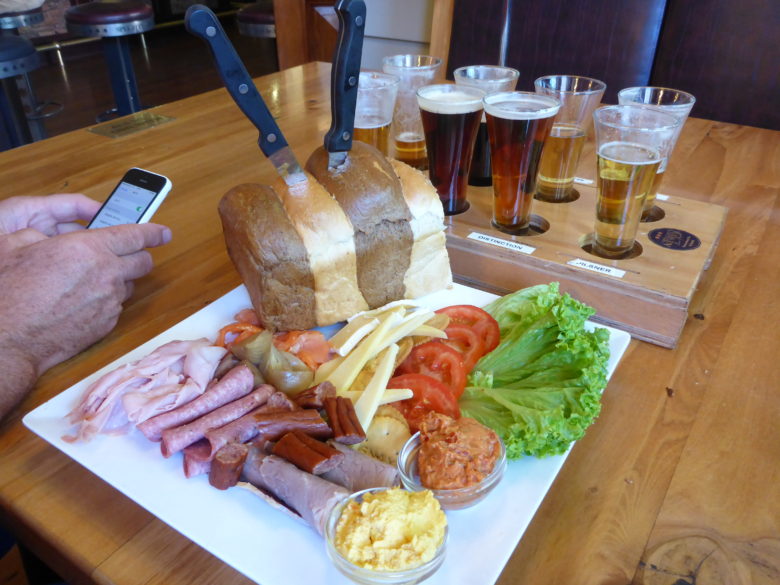The little bus almost poured us into one of the chocolate moulds at the Dunedin Cadbury factory it was so handy. The factory which provides hundreds of jobs locally is due to close at the end of the year, but we were assured by our guide, Carol, that the visitor centre would continue. Sadly it is all to be closed.
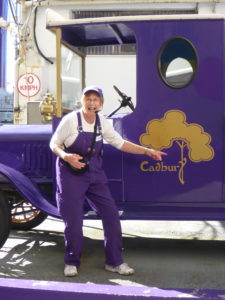
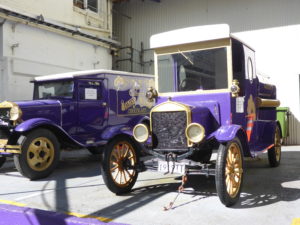
We as visitors don’t actually get to see the production part; the delicious pouring of shiny brown, polished chocolate into those choc box medleys of yumminess, or see the uniquely NZ little round bright orange Jaffas being tumbled in their lurid coating or indeed witness the birth of a thousand perfect Easter Bunnies.
But we did get the free chocolate, well my gifts were two big bars of chocolate because everything else they produce contains animal rennet and I am ‘vegetarian’ in that respect at least. Plus we climbed the steps into the purple silo to watch a ton of tempered milk chocolate fall from the top to the bottom not for any other reason than our entertainment. Dawn French, Vicar of Dibley would have appreciated that experience.
In the ‘sensory tasting lab’ we made our own chocolate concoction, pouring different flavours from taps on the side of the chocolate train into a little pot to be savoured as we followed Carol around like sheep.
The exit cunningly takes us through the shop where queues of our friends from Asia waited to have their bulging carrier bags priced up at a fraction of the shop prices. Others wanted to pose for photos under the sign and metres from their photographer, requiring an empty space for the perfect shot thus holding up the dozens trying to leave.
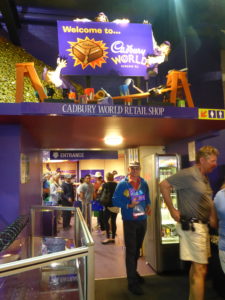
Outside the day was brilliant and hot as we boarded a 1981 beautifully restored Leyland Bus for our Headfirst Tour around the city. The driver was a volunteer who also helps in the restoration and maintenance of their fleet of 10 buses of which 8 are always working. Our guide was the marketing manager of the company.
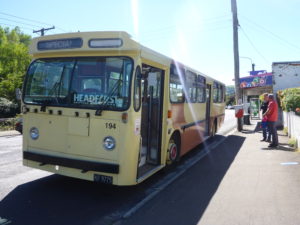
Driving slowly past the Alhambra Rugby Club she explained that mixed teams played naked in mid- winter, I had to do a quick think, which season are we in?
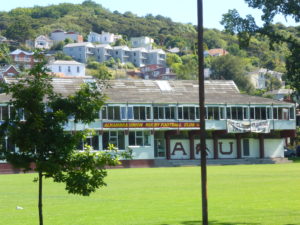
Our bus had special low ratio gears on it for the demanding hills of the city, but the ‘steepest hill in the World’ Baldwin Street was one only to be attempted by the healthiest vehicles not these precious babies. We walked up the lowest part to be told the record for running bottom to the top and back is 1 minute 58 seconds. Give me a day.
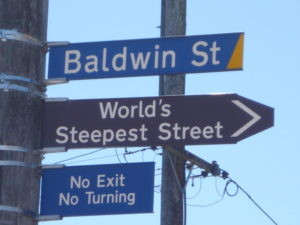
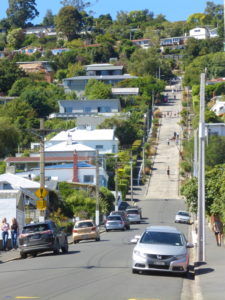
The University of Otago was demanding our attention and we chatted with a young student who agreed to pose alongside the Water of Leith, the southern relative of its Scottish cousin. New students are warned to bring woollies and plenty of scarves for the chilly winters, so they are called scarfies. But today they were all in shorts and t shirts.

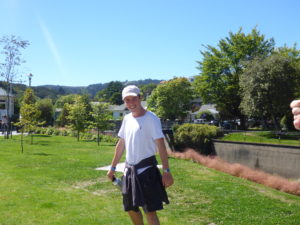
Our final stop was the architecturally beautiful Railway Station which is inside and out the finest train station I have ever seen. The care that has always been lavished on it from the internal loos to the fabulous garden at the front epitomises the civic pride taken in this ‘Scottish’ Heritage capital of NZ.

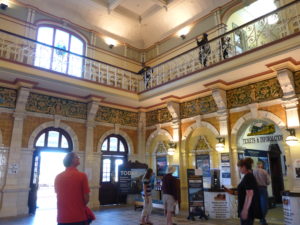
Back on our feet we had a quick look inside the Anglican St Paul’s Cathedral. When it was first opened the Scottish Presbyterians were so sick of the Anglican dominance and restrictions back home that had driven them to NZ in the first place, they unveiled a fine statue of Robby Burns right in front of the cathedral and on the same day. Love it, wish I’d been there.
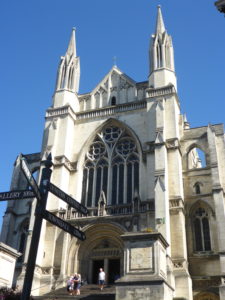
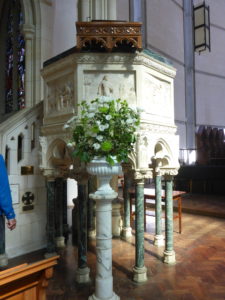
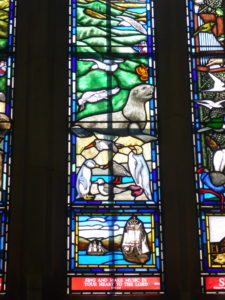
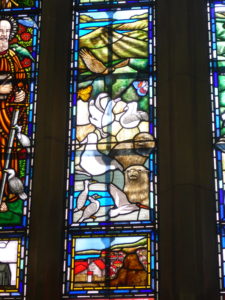
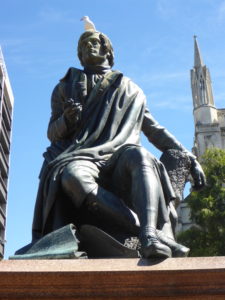
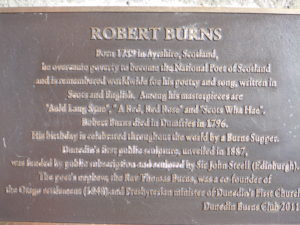
We had enjoyed a grand morning and felt the need for a little refreshment so at the Speights Brewery Ale House, Rattray Street we lunched on a sampler rack of 8 beers and an NZ version of our ploughman’s with two tone bread and almost more smoked salmon and cheese than we could eat. Fortunately I have a commodious handbag.
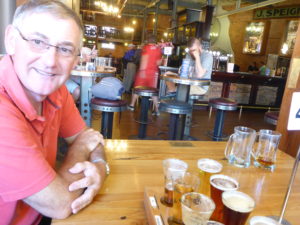
A quick call into the I-Site to book our day on Doubtful Sound in Fiordland and two night stay at Manapouri Holiday Park nearby and then we were back on the bus home to plan our drive on south to Invercargill in Southland, the next day.
Another fine day on the road.
Larnach Castle is said to be the only castle in NZ and sits on top of the Otago Peninsular just off Highcliff Road. Vicky negotiated the hairpin bends with steep drops and the single file route past numerous ongoing road repairs with her usual grace and the Castle looked magnificent in the bright sunshine.
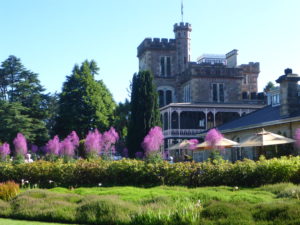
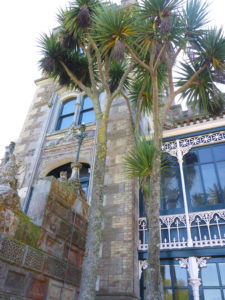
William Larnach built the castle from 1871 to 1883 for his beloved first wife Eliza Jane. He was another extraordinary man like G. Armstrong and Lord Grey of Kawau Island and Governor of NZ fame. Larnach’s many hats included landowner, Minister of the Crown, banker, financier and merchant baron. Much of his wealth was generated by the gold rush money.
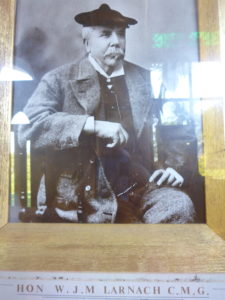
Tragically he took his own life while sitting in his office in the Parliament building in Wellington due to personal reasons (Lord Grey will have known all about that) and after much haggling over inheritance by his children and third wife the castle was sold.
The equally interesting but romantic story is how, in 1967, Margaret and Barry Barker were on their honeymoon when they stumbled upon the derelict and nearly empty castle sitting on its nest of weeds and undergrowth and decided to buy it, restore it to its original beauty and live there as a family. As soon as they could they opened their doors to the public. Margaret is pictured in this photograph with her family who now run the castle.
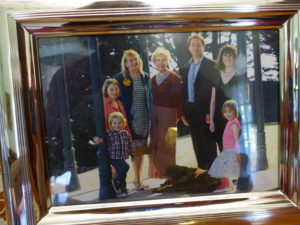
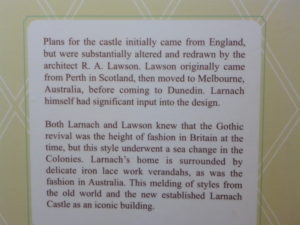
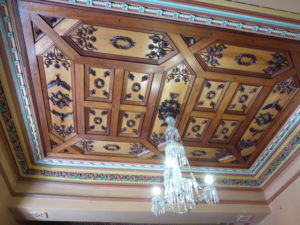

The beauty is that as one climbs the kauri wood curving staircase the views from the windows just get better and better and on the day we visited we could see out onto the glistening Pacific and right along the other way to Dunedin. The rooms are now filled with furniture and ornaments from the period, some returned to their original home.
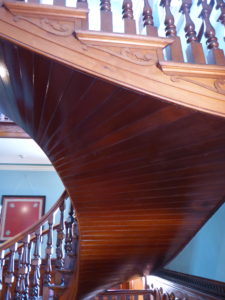
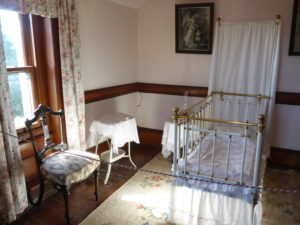
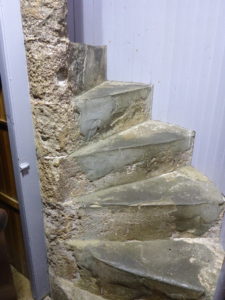


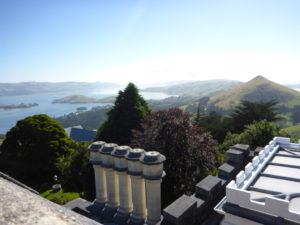
Two hours of looking was just a sweet taste of what a whole day here could be like, the house and then a wander through the Lost Rock Garden, the Tapestry Garden, raised lawn at the entrance and on into the South Seas Garden, then marvel at the methane plant where the gas from human and horse poo combined to light the gas chandeliers in the house. If you were a poppy flower sitting in the border in front of the plant you would be blue, not red. Maybe there is a connection. We had a refreshing break sitting outside the cafe.
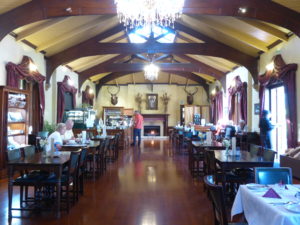
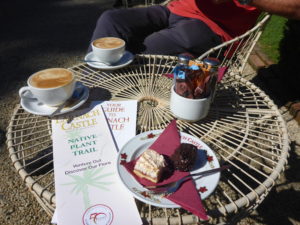
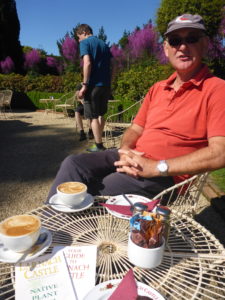
If ever you visit the South Island this place is a must if you like fine homes and gardens.
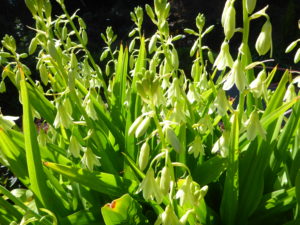
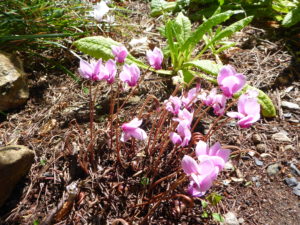
Vicky sped south west on Highway 1 with the Lammerlaw Range on our right. Red algae was choking the ditches, caused by the impure water. Double timber lorries sped past going the other way and de-forestation and pine plantations scarred the hills ahead as far as our eyes could see.
Cabbage Trees (known as Torquay palms in the UK and common also in Europe and the US) started appearing at the sides of the road and fields of dark green kale were threaded with big bale ‘eggs’ of hay in pale green plastic.
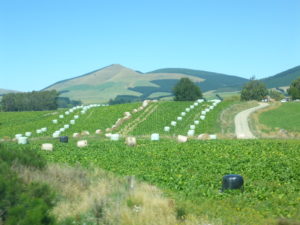
Milton and Balclutha with its big river are wealthy agricultural towns. Moving further south of course the seasons are later and the sweet smell of haymaking filled the car as we passed softly curving hills of lush green grass, no need for irrigation here. The downside was we both had hayfever!
Where there’s willow there’s water was so true here. Fluffy Red Tussock Alpaca were enjoying some shade provided by the sage green leaves of the willow, sharing cool space with sheep. Many of the shearing sheds were in use with yards of sheep awaiting the short term discomfort for the long term gain.
Half way along the journey we had a break in Gore, famous for its Hokonui moonshine. You may have noticed that we are interested in the process of making alcohol in its many delightful forms. We did not know until then that NZ had prohibition from 1901 until 1952, a depressing half century and hiding the illegal distillation of spirits from the police created stories that have gone into the folklore of the country.
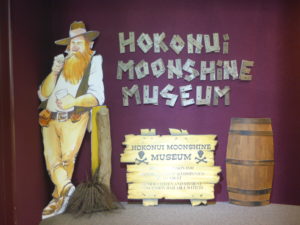
Just two examples. When the police finally gained entry into famous settler Mary’s house she was seated with her voluminous skirt over the keg for the duration of the interview. Her ‘still’ hidden in the bush ready for further use.
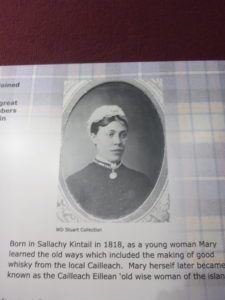
And one man who transported the finished whisky to its buyers was paid with bottles of the same. After an evening of imbibing he mentioned to the distiller “That whisky was nice but it had a different flavour,”
“Oh you must have got one of the bottles from the keg we found the rat in!”
Remember the mention of Robby Burns nephew, the Reverend Thomas Burns? Well I wonder if his religious zeal was in part a way of making up for what he perceived as his Uncle’s excesses?
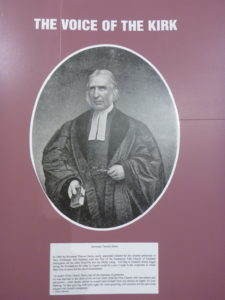
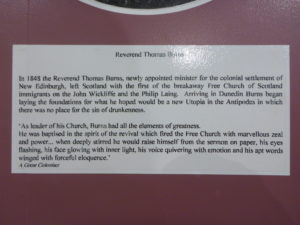

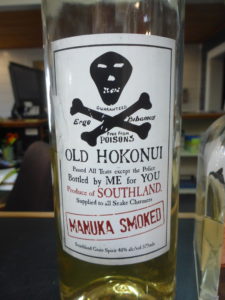
We were getting the hint that this is a windy part of the country. All of the South Island is between 40 and 50 degrees south, it is in the roaring forties so it is understandably a windy place. Very high slab sided hedges bordered the fields to break up the force of the wind. They must have really long trimming gear as some of them were twenty feet high at least.
Dairy herds used the stock underpasses as lead cows headed towards the milking parlour. Some farmers milk just once a day often in modern round and rotating parlours. Would love to watch one.
At last, after a long and quite dusty day we drove Vicky onto the hard sand of Oreti Beach south of Invercargill, where she sat happily in the company of a few other vehicles. There we soaked up our first view of the Southern Ocean that flows 360 degrees around Antarctica in the windiest part of the world and yet on that day could have gone for a pleasant sail in little Zoonie our 11 foot 3 inch 53 year old Heron dinghy. We were the furthest south we were going to be on our NZ journey and circumnavigation, from here the only way was up.

A Tale of two males from Invercargill
Staring into the sandy distance topped with clear blue sky it was easy to see and hear in one’s mind the Fastest Indian Scout, ridden by Burt Munro, race along Oreti Beach at 151.36mph exactly 60 year ago. Ten years later Burt took the little red bullet to Bonneville Salt Flats in Utah and set the World Speed Record at an average of 184.07mph. All this achieved on the same bike he bought for $120, 57 years before.
When he emerged from the bike onlookers were not as surprised by the bike or the achievement as they were by his age. Born in 1899 Burt’s famous quote was “You live more in five minutes on a bike like this than most people do in a lifetime”.
Invercargill remembers him well. He gave his collection of bikes and most of the contents of his shed, including all the broken and spare parts and his trailer to Norman and Neville Hayes who ran the family business of farming and engineering products, many invented in house. Today the descendants still run the E. Hayes family store, which had diversified into hardware, engineering and homeware products and services.
The store is vast and beautifully set out and lit and includes their famous 100 metre tool wall. Woven in with the shelves of products is an extensive collection of classic, vintage and modern motorcycles, automobiles, engines and memorabilia which is free to view during shop hours.
The prize exhibits tell the story of Burt’s speed record career and its world fame preserved in the film starring Anthony Hopkins which is shown continuously from a wall mounted TV. I sat watching the film and sipping complimentary hot chocolate while Rob chatted to the sales assistant.
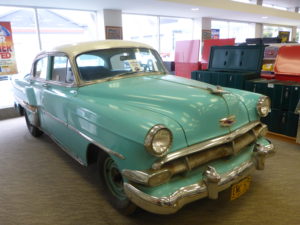
There are numerous replicas of the Fastest Indian which were used in the film and customers can climb into one of them and imagine for a few moments the thrill of speed that was the essence of Burt’s life. Rob took no encouraging!
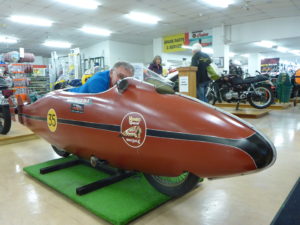
Born at around the same time as Burt and still alive today is a direct descendant from the age of dinosaurs, Henry the lizard-like Tuatara. He is a venerable old reptile who came to enjoy mating very late in life due to a libido suppressing growth in his rear end. After a clever lady vet took the risk of removing the passion killing mass Henry was ready for some of what comes naturally.
Tuataras, like so many indigenous ground dwelling animals in NZ have suffered predation from the likes of introduced cats, dogs, rats and possums and they thrive now mostly on outlying islands. So on the I-Site/museum campus there is a breeding programme in which he is only too willing to participate.
Looking into his light and airy home, linked by open topped glass walls to the outside atmosphere, I watched him in his little burrow peeping out and very still. He used to attack all the females he was put in contact with so originally another male was brought in. That male was so successful he had to be isolated for fear of the gene pool becoming too limited and the poor little chap, deprived of his role in life, literally lost the will to live and faded away. So now it’s down to Henry.
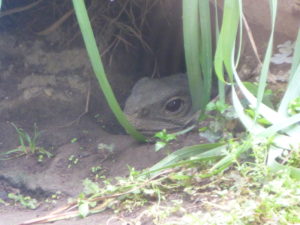
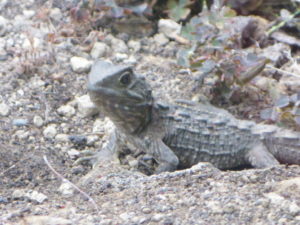
For our short stay in Invercargill we camped in the Central City Park and had a little issues with the local birds and the air mattress. On our first morning we awoke to feel deflated and see spots before our eyes. The air mattress had oozed air during the night. “I’m not having this, I won’t sleep on the ground!”
“But darling I’m ok, there’s still a little buoyancy between me and the floor.” I was fearing the looming expense of a replacement.
“That’s because I am heavier than you so I am keeping you afloat!” The dynamics made us laugh. But emerging from the tent the cause of the spots wiped the smile from our faces. It was covered with Tui poo, bird bombs, yucky guano, name it what you like our little tent was crying shit.
So while Rob slithered around the airbed with a soapy sponge trying to find the leak I slithered around the roof of the tent with the same and thought we could drag it out from under the trees into a patch of clear sky and hope the birds only pooped when perched.
No such luck. The next morning it was just as bad. Goodness knows what they ate around there but they sure had plenty of it.
In the Outdoor store, Kathmandu, Rob and I suggested the lady staff member give us a little space so we could have a calm domestic about the merits of buying a new-fangled, self-inflating, wallet shrinking airbed. $230 later the air was pale blue as we returned to the sanctuary of Vicky, Rob delighted with his acquisition and me wondering how to restart a conversation.
Problem is I used to find it a bit hard even using our squeaky stirrup pump, to the amusement of neighbouring campers, to do the required number of pumps to fill our $20 Warehouse special, so poor Rob usually at least finished it for me. I was very good a falling all over it the next morning to make it small enough for its bag.
Well now the problem is reversed. I happily lay out the new bed on the foam rolls and undo the valve, listening as it takes a mighty intake of breath while the soft springs inside straighten out. But the next morning it takes all my body weight and a few risky jumps up and down to make it small enough to stow away. Ah well, that’s camping.
While using the camp kitchen for breakfast and dinner we had some interesting chats with two couples about freedom camping. We had heard various NZ resident views and wanted to know if the public consensus against them was fair or just the narrow views of those who generalise about the actions of a few.
Both couples combined official sites like the one we were in with freedom sites, so they could have showers for example. The older couple had been doing it and loving it for years and met many fellow freedom campers with like minds and the younger couple from London plan to do the same in other countries. They said they would only do it if there were others there, safety in numbers, but the older couple have pitched alone in many places.
Neither had seen evidence of the unpleasant habits we had heard typified them and they felt they contributed as much to the economy as anyone else camping on a budget.
The tent now nice and clean and the airbed tucked away we turned onto Highway 99, The Southern Route and enjoyed the last glimpses we would have of the Southern Ocean. The beautiful expanse of Colac Bay in the Foreaux Straight was a surfers’ paradise for the waves rolled in uninterrupted from the ocean, missing Stewart Island around the corner. The land either side of us was far away farming with the Longwood Range of hills on the right covered in native bush.
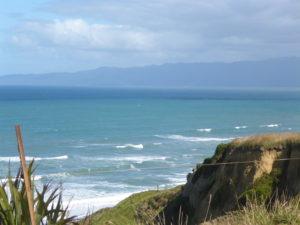
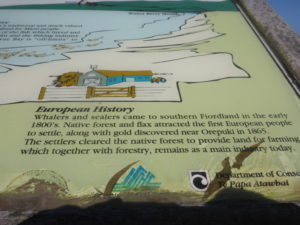
Sheep and cattle grazed naturally green pasture. Pretty belted Galloway cattle spotted the hillsides, a wetlands reserve looked after the needs of water fowl and high wire fences enclosed deer farms, stocked originally from the over-abundance of wild deer introduced from Scotland for the rich countryfolk to hunt and now a lucrative income is made from farmed and hunted deer.
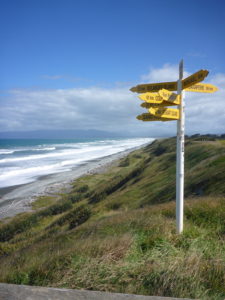
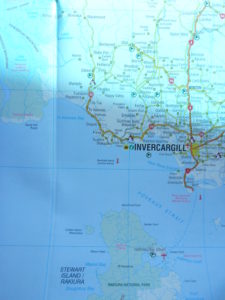
Flax, Pampas grass, willow, orange blooming Monbretia, palms and broom bordered the roadside as the psychological second half of our journey unrolled before us. We were heading for Fjordland.
